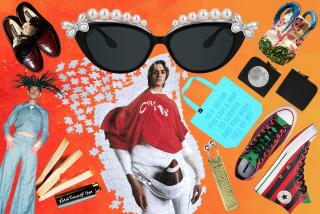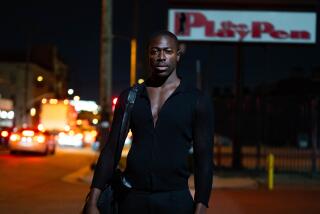Fashion Institute’s exhibit ‘Aesthetes, Bohemians & Craftsmen’ to open May 20
“DATE this for me,” challenges Kevin Jones, pointing to a caftan zigzagged with furious streaks of color.
Jones, in his office at the Fashion Institute of Design & Merchandising, has pulled this wild bit of psychedelia from his archives -- tie-dyed, see-through silk, floor-length, edges finished in minuscule picot stitching, hem left ragged and raw.
What could be more 1960s?
“It’s 1920s,” he says, still thrilled by the discovery. “There is absolutely no construction to this garment. It was the complete antithesis of fashion. This just kills me.”
Jones, museum curator at the fashion college, has been collecting examples from this era for five years, and now they’re on display in a exhibition, “Aesthetes, Bohemians & Craftsmen: Artistic Dress, 1880s-1920s.” The caftan is one of many pieces that mark the end of the corseted Victorian era, and the beginning of a revolution in design and culture that’s still rumbling on today.
The FIDM exhibit -- which coincides with a related show at the historic Gamble House in Pasadena -- opens with Victorian ensembles so stiff, artificial and over-decorated that it’s easy to imagine why there was a revolt. Taking cues from the Arts and Crafts movement -- with its theories about liberated design in an industrialized age -- avant-garde designers created looks that freed women from corsetry and unnatural padding; made menswear acceptable as women’s attire; and brought peasant dress and ethnic motifs into vogue. The clothes, and their wearers, shocked the world and set the stage for today’s culture of celebrity designers.
Raymond Duncan, and his sister the dancer, Isadora, personified the era’s rebellious spirit. Shuttling between Paris and the U.S., she was a champion of modern dance and dress; he was a poet, printer and one of the modern era’s first artists who found acceptance, expression and influence in fashion.
“He was this totally out-there artist, I mean out there,” Jones says. “He was raising sheep, spinning their wool, living in a commune before there were communes . . . and he was totally into Greek dress.”
It was the Duncans and their eccentric friends who first wore Greek sandals in New York winters and had the habit of tossing away their newly purchased Parisian couture from moving trains. They promoted, then just as quickly rejected, new ideas in dress, and laid the foundation for our rapidly churning fashion cycle. And their obsession with nature, the handmade and unique (as opposed to the mass produced garments made possible by the Industrial Revolution) can be seen as the beginnings of today’s green fashion movement.
“I see students walking around here in clothing that was inspired by this era,” Jones says, “and they have no idea that it would have been their great-great-grandmother’s shocking clothing.”
“Aesthetes, Bohemians & Craftsmen: Artistic Dress, 1880s-1920s” runs Tuesdays through Sundays, through July 2, at the FIDM Museum and Galleries, 919 S. Grand Ave., L.A.; 10 a.m. to 4 p.m. (800) 624-1200, Ext. 22
More to Read
Sign up for our L.A. Times Plants newsletter
At the start of each month, get a roundup of upcoming plant-related activities and events in Southern California, along with links to tips and articles you may have missed.
You may occasionally receive promotional content from the Los Angeles Times.






